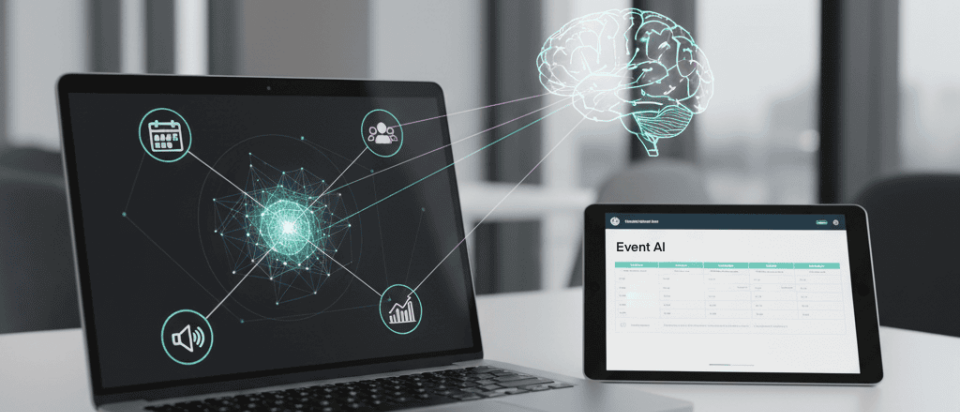
In the modern world of events, we're juggling countless data points. But are we truly using them? Too often, we still fall back on our gut feeling. But what if you could make decisions based not just on experience, but on precise, data-driven forecasts?
This is exactly where Artificial Intelligence (AI) comes in. AI is no longer a distant dream; it's the crucial tool that takes smart event planning to the next level. You just need to know how to use it right.
Why Traditional Event Analytics Fall Short
This shift from reactive to proactive planning is driven by a simple truth: expectations have risen. Traditional KPIs like attendee numbers, conversion rates, or feedback from surveys are like looking in the rear-view mirror. They show you where you've been, but not where you're headed. They are backward-looking and provide few meaningful predictions for your next event.

For forward-thinking event planning, manual data analysis is no longer enough.
To not only manage events but to strategically scale them, you need analytics that can identify patterns in real-time and predict future trends. You need a view through the windshield. And that’s precisely what modern, AI-powered event analysis provides. The foundation for this is clean, centralized data collection, from the very first touchpoint to the final feedback.
4 Ways AI Will Revolutionize Your Event Planning
The idea of using Artificial intelligence might sound complex, but the key is to break it down into concrete, impactful steps. These four use cases show you where you can start to achieve the biggest impact.
Tip 1: Understand Your Audience, Don't Just Count Them
AI-powered analytics can identify complex patterns in large datasets. Instead of just seeing who attended, you can understand how different groups behave. Artificial intelligence can automatically create clusters, segmenting attendees by interests, behavior, or engagement levels. This allows you to plan program slots based on data, personalize follow-ups for specific target groups, and understand which content truly resonates with which segment.
Tip 2: Predict the Future Instead of Just Evaluating the Past
This is the game-changer. With predictive analytics, you can forecast your event's potential for success. Instead of just hoping, you can make informed predictions about how many leads a specific event format might generate in a particular location. AI-driven scenario analysis ("What if…?") also prepares you for potential outcomes, making your planning more robust and agile.
Tip 3: Personalize and Automate Your Event Marketing
Imagine if your marketing could connect with potential attendees on the topics they're most passionate about. AI makes this a reality. By analyzing past interactions, it suggests personalized copy and content. Using the right prompts, you can speed up this creative process, effortlessly crafting everything from email subject lines to social media posts. This not only boosts your conversion rate but also fosters a stronger bond by making your audience feel truly seen and understood.
Tip 4: Realistically Assess Opportunities and Risks
With all the excitement, it's crucial to stay grounded. While AI is an incredibly powerful assistant, it's no substitute for human intuition and strategic vision. The quality of your data is paramount, and the "garbage in, garbage out" principle doesn't just apply to data, it applies to the quality of your prompts too. Transparency and data privacy are non-negotiable. Consider Artificial intelligence a tool that gives you superpowers, but remember, you are always the one in control.
Frequently Asked Questions
Not necessarily. You can get started with smart event management platforms that already offer AI-powered features or the necessary data structure. The key is to begin with a clear goal in mind rather than trying to build a massive infrastructure right away.
This is an absolutely crucial point. Any reputable AI application in the events industry must be GDPR-compliant. This means the platform should process data in an anonymized or pseudonymized way. As a general rule, you should never feed sensitive data like names, email addresses, or company numbers directly into the tool. This ensures you always maintain full control and transparency over what happens to your data.
By seeing AI for what it is: a decision-support tool. The data and forecasts provided by AI offer a solid foundation, but the final creative and strategic decisions are still made by you and your team.
Quite the opposite. AI is designed to handle the time-consuming, repetitive tasks—like manually sifting through data or creating initial drafts. This frees you up to focus on what truly matters: high-level strategy, creative design, and personal engagement with your attendees and partners. You'll evolve from being simply an organizer into a strategic event designer.
Conclusion
As you can see, embracing AI in your event planning is a strategic move for the future. This approach is built on a solid strategy that avoids the classic pitfalls of event planning right from the start. It’s not about automating everything overnight. Instead, it’s about asking one crucial question with every decision you make: How can I support this choice with data?
Each of the tips mentioned here is a step away from relying on gut feeling and a move toward intelligent, scalable success. Start where you have the most leverage. Perhaps with personalizing your marketing or analyzing your target audience. Progress is more important than perfection. The transparent use of data will not only improve your events but also position your brand as innovative and forward-thinking. You're not just designing an event; you're shaping the future of your entire event strategy.
To support you with this first, impactful step in digital attendee management, you can now book a demo or try Sweap for free.
